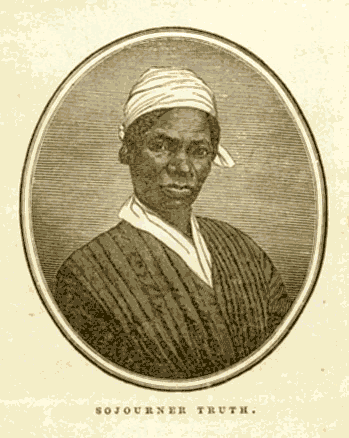Sojourner Truth
Today, a slave teaches us about our own capacities. The University of Houston's College of Engineering presents this series about the machines that make our civilization run, and the people whose ingenuity created them.
A slave named Isabelle was born in 1797 in upstate New York. It was a bad time. Eli Whitney (or his slave -- we don't know) had just invented the cotton gin. Slavery had been on its last legs in America. Now, Southern cotton became profitable. Slavery was on the rise again.
There was no cotton in New York, but Belle was no less a slave. She grew to six feet. She was strong. She was smart. She was a valuable property. She grew up on a Dutch speaking farm. They sold her to an English speaking farm. There she was whipped, married off, and separated from husband and children.
New York slaves weren't freed until 1827. Soon after that, some inner voice spoke to Belle. She packed her bags and set out to be free -- a 32 year old field hand with no means -- only a driving and inexplicable inner fire.
She went to New York City. She was a religious seeker for the next 16 years. She went from one church to another, process ing all she saw -- love and hypocrisy, generosity and greed. She also honed her peculiar talent for poetry, song, and oratory.
Then, in 1843, she took up her bindlestick and walked away from New York. She didn't know where she was headed -- only that she had a mission. Clear of the city, she stopped at a well. A woman asked her name. "It is Sojourner," she answered, hardly knowing why. But Sojourner had no surname. She prayed for a name with -- in her words -- a handle on it. And the name came to her. It was Truth.
That settled, Sojourner Truth continued across the land. She stopped at camp meetings. She began preaching. She shaped a theology of social activism. She became an integral part of the abolition movement. As Sojourner Truth, she appeared on the dais with Frederick Douglas and William Lloyd Garrison. Harriet Beecher Stowe took up her cause and wrote about her.
Sojourner Truth was in her sixties when the Civil War began. By then her powerful lean figure had touched America. She'd sung and spoken the evils of slavery with first-hand eloquence. Like Martin Luther King's message, hers was also bedded in inescapable Biblical imperatives.
She met Lincoln during the Civil War. He was honored, he told her. He'd known her work for years. After the war, she continued fighting for the rights and well-being of freed slaves. She went to Kansas to work for the resettlement of slaves there.
Sojourner Truth was 83 when she died. She'd never learned to read and write. But she had a mind and she'd learned to trust that mind. She'd used it to change herself and to change America.
I'm John Lienhard at the University of Houston, where we're interested in the way inventive minds work.
(Theme music)
Bernard, J., Journey Toward Freedom: The Story of Sojourner Truth. New York: W.W. Norton & Company, Inc., 1967.
I've given Sojourner Truth's birthdate as 1797. That date is approximate. The exact date isn't known. A lot of mythology surrounded her toward the end. Some claimed that she was 105 when she died. More likely, she was only 83. Two important sources of information on Sojourner Truth are:
Truth, S., Narrative of Sojourner Truth. (as taken down by Olive Gilbert.) Boston: 1850 (final ed. Battle Creek: 1884.)
Stowe, H.B., The Libyan Sibyl. The Atlantic Monthly, ca. 1853-1856.
I am grateful to Pat Bozeman, Head of Special Collections, UH Library, for drawing my attention to the story of Sojourner Truth.

Image courtesy of Special Collections, UH Library
From The Narrative of Sojourner Truth, 1850